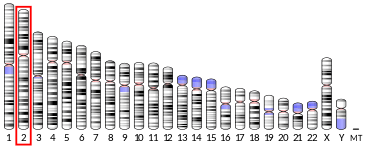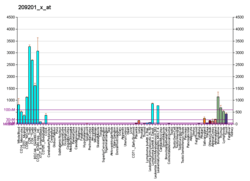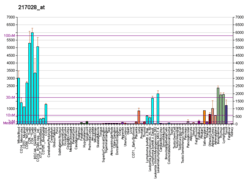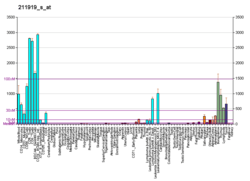CXCR4
C-X-C chemokine receptor type 4 (CXCR-4) also known as fusin or CD184 (cluster of differentiation 184) is a protein that in humans is encoded by the CXCR4 gene.[5][6]
Function
CXCR-4 is an alpha-chemokine receptor specific for stromal-derived-factor-1 (SDF-1 also called CXCL12), a molecule endowed with potent chemotactic activity for lymphocytes. CXCR4 is one of several chemokine co-receptors that HIV can use to infect CD4+ T cells. HIV isolates that use CXCR4 are traditionally known as T-cell tropic isolates. Typically, these viruses are found late in infection. It is unclear as to whether the emergence of CXCR4-using HIV is a consequence or a cause of immunodeficiency.[7]
CXCR4 is upregulated during the implantation window in natural and hormone replacement therapy cycles in the endometrium, producing, in presence of a human blastocyst, a surface polarization of the CXCR4 receptors suggesting that this receptor is implicated in the adhesion phase of human implantation.
CXCR4's ligand SDF-1 is known to be important in hematopoietic stem cell homing to the bone marrow and in hematopoietic stem cell quiescence. It has been also shown that CXCR4 signalling regulates the expression of CD20 on B cells. Until recently, SDF-1 and CXCR4 were believed to be a relatively monogamous ligand-receptor pair (other chemokines are promiscuous, tending to use several different chemokine receptors). Recent evidence demonstrates ubiquitin is also a natural ligand of CXCR4.[8] Ubiquitin is a small (76-amino acid) protein highly conserved among eukaryotic cells. It is best known for its intracellular role in targeting ubiquitylated proteins for degradation via the ubiquitin proteasome system. Evidence in numerous animal models suggests ubiquitin is anti-inflammatory immune modulator and endogenous opponent of proinflammatory damage associated molecular pattern molecules.[9] It is speculated this interaction may be through CXCR4 mediated signalling pathways. MIF is an additional ligand of CXCR4[10]
CXCR4 is present in newly generated neurons during embryogenesis and adult life where it plays a role in neuronal guidance. The levels of the receptor decrease as neurons mature. CXCR4 mutant mice have aberrant neuronal distribution. This has been implicated in disorders such as epilepsy.[11]
Clinical significance
Drugs that block the CXCR4 receptor appear to be capable of "mobilizing" hematopoietic stem cells into the bloodstream as peripheral blood stem cells. Peripheral blood stem cell mobilization is very important in hematopoietic stem cell transplantation (as a recent alternative to transplantation of surgically harvested bone marrow) and is currently performed using drugs such as G-CSF. G-CSF is a growth factor for neutrophils (a common type of white blood cells), and may act by increasing the activity of neutrophil-derived proteases such as neutrophil elastase in the bone marrow leading to proteolytic degradation of SDF-1. Plerixafor (AMD3100) is a drug, approved for routine clinical use,[12] which directly blocks the CXCR4 receptor. It is a very efficient inducer of hematopoietic stem cell mobilization in animal and human studies. In a small human clinical trial to evaluate the safety and efficacy of fucoidan ingestion (brown seaweed extract), 3g daily of 75% w/w oral fucoidan for 12 days increased the proportion of CD34+CXCR4+ from 45 to 90% and the serum SDF-1 levels, which could be useful in CD34+ cells homing/mobilization via SDF-1/CXCR4 axis.[13]
It has been associated with WHIM syndrome.[14] WHIM like mutations in CXCR4 were recently identified in patients with Waldenström's macroglobulinemia, a B-cell malignancy.[15] The presence of CXCR4 WHIM mutations has been associated with clinical resistance to ibrutinib in patients with Waldenström's macroglobulinemia.[16]
While CXCR4's expression is low or absent in many healthy tissues, it was demonstrated to be expressed in over 23 types of cancer, including breast cancer, ovarian cancer, melanoma, and prostate cancer. Expression of this receptor in cancer cells has been linked to metastasis to tissues containing a high concentration of CXCL12, such as lungs, liver and bone marrow.[17][18] However, in breast cancer where SDF1/CXCL12 is also expressed by the cancer cells themselves along with CXCR4, CXCL12 expression is positively correlated with disease free (metastasis free) survival. CXCL12 (over-)expressing cancers might not sense the CXCL12 gradient released from the metastasis target tissues since the receptor, CXCR4, is saturated with the ligand produced in an autocrine manner.[19] Another explanation of this observation is provided by a study that shows the ability of CXCL12 (and CCL2) producing tumors to entrain neutrophils that inhibit seeding of tumor cells in the lung.[20]
Drug response
Chronic exposure to THC has been shown to increase T lymphocyte CXCR4 expression on both CD4+ and CD8+ T lymphocytes in rhesus macaques.[21] It has been shown that BCR signalling inhibitors also affect CXCR4 pathway and thus CD20 expression.
Interactions
CXCR4 has been shown to interact with USP14.[22]
See also
- CXCR4 antagonist
- HIV tropism
- Entry inhibitor
- Discovery and development of CCR5 receptor antagonists
References
- GRCh38: Ensembl release 89: ENSG00000121966 - Ensembl, May 2017
- GRCm38: Ensembl release 89: ENSMUSG00000045382 - Ensembl, May 2017
- "Human PubMed Reference:". National Center for Biotechnology Information, U.S. National Library of Medicine.
- "Mouse PubMed Reference:". National Center for Biotechnology Information, U.S. National Library of Medicine.
- Moriuchi M, Moriuchi H, Turner W, Fauci AS (November 1997). "Cloning and analysis of the promoter region of CXCR4, a coreceptor for HIV-1 entry". Journal of Immunology. 159 (9): 4322–9. PMID 9379028.
- Caruz A, Samsom M, Alonso JM, Alcami J, Baleux F, Virelizier JL, Parmentier M, Arenzana-Seisdedos F (April 1998). "Genomic organization and promoter characterization of human CXCR4 gene". FEBS Letters. 426 (2): 271–8. doi:10.1016/S0014-5793(98)00359-7. PMID 9599023.
- Mostashari-Rad T, Arian R, Sadri H, Mehridehnavi A, Ghasemi F, Fassihi A (May 2019). "Study of CXCR4 Chemokine Receptor Inhibitors Using QSPR and Molecular Docking Methodologies". Journal of Theoretical and Computational Chemistry. 1 (1): 1950018. doi:10.1142/S0219633619500184.
- Saini V, Marchese A, Majetschak M (May 2010). "CXC chemokine receptor 4 is a cell surface receptor for extracellular ubiquitin". The Journal of Biological Chemistry. 285 (20): 15566–76. doi:10.1074/jbc.M110.103408. PMC 2865327. PMID 20228059.
- Majetschak M (February 2011). "Extracellular ubiquitin: immune modulator and endogenous opponent of damage-associated molecular pattern molecules". Journal of Leukocyte Biology. 89 (2): 205–19. doi:10.1189/jlb.0510316. PMID 20689098.
- Bernhagen J, Krohn R, Lue H, Gregory JL, Zernecke A, Koenen RR, Dewor M, Georgiev I, Schober A, Leng L, Kooistra T, Fingerle-Rowson G, Ghezzi P, Kleemann R, McColl SR, Bucala R, Hickey MJ, Weber C (May 2007). "MIF is a noncognate ligand of CXC chemokine receptors in inflammatory and atherogenic cell recruitment". Nature Medicine. 13 (5): 587–96. doi:10.1038/nm1567. PMID 17435771.
- Bagri A, Gurney T, He X, Zou YR, Littman DR, Tessier-Lavigne M, Pleasure SJ (September 2002). "The chemokine SDF1 regulates migration of dentate granule cells". Development. 129 (18): 4249–60. PMID 12183377.
- To LB, Levesque JP, Herbert KE (October 2011). "How I treat patients who mobilize hematopoietic stem cells poorly". Blood. 118 (17): 4530–40. doi:10.1182/blood-2011-06-318220. PMID 21832280. S2CID 2543277.
- Irhimeh, Mohammad R.; Fitton, J. Helen; Lowenthal, Raymond M. (June 2007). "Fucoidan ingestion increases the expression of CXCR4 on human CD34+ cells". Experimental Hematology. 35 (6): 989–994. doi:10.1016/j.exphem.2007.02.009. PMID 17533053.
- Balabanian K, Levoye A, Klemm L, Lagane B, Hermine O, Harriague J, Baleux F, Arenzana-Seisdedos F, Bachelerie F (March 2008). "Leukocyte analysis from WHIM syndrome patients reveals a pivotal role for GRK3 in CXCR4 signaling". The Journal of Clinical Investigation. 118 (3): 1074–84. doi:10.1172/JCI33187. PMC 2242619. PMID 18274673.
- Hunter ZR, Xu L, Yang G, Zhou Y, Liu X, Cao Y, Manning RJ, Tripsas C, Patterson CJ, Sheehy P, Treon SP (March 2014). "The genomic landscape of Waldenstrom macroglobulinemia is characterized by highly recurring MYD88 and WHIM-like CXCR4 mutations, and small somatic deletions associated with B-cell lymphomagenesis". Blood. 123 (11): 1637–46. doi:10.1182/blood-2013-09-525808. PMID 24366360.
- Treon SP, Tripsas CK, Meid K, Warren D, Varma G, Green R, et al. (2015). "Ibrutinib in previously treated Waldenstrom macroglobulinemia". N. Engl. J. Med. 372 (15): 1430–40. doi:10.1056/NEJMoa1501548. PMID 25853747.
- Sun X, Cheng G, Hao M, Zheng J, Zhou X, Zhang J, Taichman RS, Pienta KJ, Wang J (December 2010). "CXCL12 / CXCR4 / CXCR7 chemokine axis and cancer progression". Cancer Metastasis Reviews. 29 (4): 709–22. doi:10.1007/s10555-010-9256-x. PMC 3175097. PMID 20839032.
- Balkwill F (July 2004). "Cancer and the chemokine network". Nature Reviews. Cancer. 4 (7): 540–50. doi:10.1038/nrc1388. PMID 15229479.
- Mirisola V, Zuccarino A, Bachmeier BE, Sormani MP, Falter J, Nerlich A, Pfeffer U (September 2009). "CXCL12/SDF1 expression by breast cancers is an independent prognostic marker of disease-free and overall survival". European Journal of Cancer. 45 (14): 2579–87. doi:10.1016/j.ejca.2009.06.026. PMID 19646861.
- Granot Z, Henke E, Comen EA, King TA, Norton L, Benezra R (September 2011). "Tumor entrained neutrophils inhibit seeding in the premetastatic lung". Cancer Cell. 20 (3): 300–14. doi:10.1016/j.ccr.2011.08.012. PMC 3172582. PMID 21907922.
- LeCapitaine NJ, Zhang P, Winsauer P, Walker E, Vande Stouwe C, Porretta C, Molina PE (December 2011). "Chronic Δ-9-tetrahydrocannabinol administration increases lymphocyte CXCR4 expression in rhesus macaques". Journal of Neuroimmune Pharmacology. 6 (4): 540–5. doi:10.1007/s11481-011-9277-4. PMC 3181271. PMID 21484257.
- Mines MA, Goodwin JS, Limbird LE, Cui FF, Fan GH (February 2009). "Deubiquitination of CXCR4 by USP14 is critical for both CXCL12-induced CXCR4 degradation and chemotaxis but not ERK activation". The Journal of Biological Chemistry. 284 (9): 5742–52. doi:10.1074/jbc.M808507200. PMC 2645827. PMID 19106094.
Further reading
- Wilkinson D (September 1996). "Cofactors provide the entry keys. HIV-1". Current Biology. 6 (9): 1051–3. doi:10.1016/S0960-9822(02)70661-1. PMID 8805353.
- Broder CC, Dimitrov DS (1996). "HIV and the 7-transmembrane domain receptors". Pathobiology. 64 (4): 171–9. doi:10.1159/000164032. PMID 9031325.
- Choe H, Martin KA, Farzan M, Sodroski J, Gerard NP, Gerard C (June 1998). "Structural interactions between chemokine receptors, gp120 Env and CD4". Seminars in Immunology. 10 (3): 249–57. doi:10.1006/smim.1998.0127. PMID 9653051.
- Freedman BD, Liu QH, Del Corno M, Collman RG (2003). "HIV-1 gp120 chemokine receptor-mediated signaling in human macrophages". Immunologic Research. 27 (2–3): 261–76. doi:10.1385/IR:27:2-3:261. PMID 12857973.
- Esté JA (September 2003). "Virus entry as a target for anti-HIV intervention". Current Medicinal Chemistry. 10 (17): 1617–32. doi:10.2174/0929867033457098. PMID 12871111.
- Gallo SA, Finnegan CM, Viard M, Raviv Y, Dimitrov A, Rawat SS, Puri A, Durell S, Blumenthal R (July 2003). "The HIV Env-mediated fusion reaction". Biochimica et Biophysica Acta (BBA) - Biomembranes. 1614 (1): 36–50. doi:10.1016/S0005-2736(03)00161-5. PMID 12873764.
- Zaitseva M, Peden K, Golding H (July 2003). "HIV coreceptors: role of structure, posttranslational modifications, and internalization in viral-cell fusion and as targets for entry inhibitors". Biochimica et Biophysica Acta (BBA) - Biomembranes. 1614 (1): 51–61. doi:10.1016/S0005-2736(03)00162-7. PMID 12873765.
- Lee C, Liu QH, Tomkowicz B, Yi Y, Freedman BD, Collman RG (November 2003). "Macrophage activation through CCR5- and CXCR4-mediated gp120-elicited signaling pathways". Journal of Leukocyte Biology. 74 (5): 676–82. doi:10.1189/jlb.0503206. PMID 12960231. S2CID 11362623.
- Yi Y, Lee C, Liu QH, Freedman BD, Collman RG (2004). "Chemokine receptor utilization and macrophage signaling by human immunodeficiency virus type 1 gp120: Implications for neuropathogenesis". Journal of Neurovirology. 10. 10 Suppl 1: 91–6. doi:10.1080/753312758. PMID 14982745.
- Seibert C, Sakmar TP (2004). "Small-molecule antagonists of CCR5 and CXCR4: a promising new class of anti-HIV-1 drugs". Current Pharmaceutical Design. 10 (17): 2041–62. doi:10.2174/1381612043384312. PMID 15279544.
- Perfettini JL, Castedo M, Roumier T, Andreau K, Nardacci R, Piacentini M, Kroemer G (August 2005). "Mechanisms of apoptosis induction by the HIV-1 envelope". Cell Death and Differentiation. 12. 12 Suppl 1: 916–23. doi:10.1038/sj.cdd.4401584. PMID 15719026.
- King JE, Eugenin EA, Buckner CM, Berman JW (April 2006). "HIV tat and neurotoxicity". Microbes and Infection / Institut Pasteur. 8 (5): 1347–57. doi:10.1016/j.micinf.2005.11.014. PMID 16697675.
- Kryczek I, Wei S, Keller E, Liu R, Zou W (March 2007). "Stroma-derived factor (SDF-1/CXCL12) and human tumor pathogenesis". American Journal of Physiology. Cell Physiology. 292 (3): C987-95. doi:10.1152/ajpcell.00406.2006. PMID 16943240. S2CID 7423893.
- Arya M, Ahmed H, Silhi N, Williamson M, Patel HR (2007). "Clinical importance and therapeutic implications of the pivotal CXCL12-CXCR4 (chemokine ligand-receptor) interaction in cancer cell migration". Tumour Biology. 28 (3): 123–31. doi:10.1159/000102979. PMID 17510563.
- Grange JM (December 1979). "Tuberculosis: the changing tubercle". British Journal of Hospital Medicine. 22 (6): 540–8. PMID 118789.
- Nomura H, Nielsen BW, Matsushima K (October 1993). "Molecular cloning of cDNAs encoding a LD78 receptor and putative leukocyte chemotactic peptide receptors". International Immunology. 5 (10): 1239–49. doi:10.1093/intimm/5.10.1239. PMID 7505609.
- Lu ZH, Wang ZX, Horuk R, Hesselgesser J, Lou YC, Hadley TJ, Peiper SC (November 1995). "The promiscuous chemokine binding profile of the Duffy antigen/receptor for chemokines is primarily localized to sequences in the amino-terminal domain". The Journal of Biological Chemistry. 270 (44): 26239–45. doi:10.1074/jbc.270.44.26239. PMID 7592830.
- Jazin EE, Yoo H, Blomqvist AG, Yee F, Weng G, Walker MW, Salon J, Larhammar D, Wahlestedt C (September 1993). "A proposed bovine neuropeptide Y (NPY) receptor cDNA clone, or its human homologue, confers neither NPY binding sites nor NPY responsiveness on transfected cells". Regulatory Peptides. 47 (3): 247–58. doi:10.1016/0167-0115(93)90392-L. PMID 8234909.
- Loetscher M, Geiser T, O'Reilly T, Zwahlen R, Baggiolini M, Moser B (January 1994). "Cloning of a human seven-transmembrane domain receptor, LESTR, that is highly expressed in leukocytes". The Journal of Biological Chemistry. 269 (1): 232–7. PMID 8276799.
- Wang J, Liu X, Lu H, Jiang C, Cui X, Yu L, Fu X, Li Q, Wang J (March 2015). "CXCR4(+)CD45(-) BMMNC subpopulation is superior to unfractionated BMMNCs for protection after ischemic stroke in mice". Brain, Behavior, and Immunity. 45: 98–108. doi:10.1016/j.bbi.2014.12.015. PMC 4342301. PMID 25526817.
- Wang J, Yu L, Jiang C, Fu X, Liu X, Wang M, Ou C, Cui X, Zhou C, Wang J (January 2015). "Cerebral ischemia increases bone marrow CD4+CD25+FoxP3+ regulatory T cells in mice via signals from sympathetic nervous system". Brain, Behavior, and Immunity. 43: 172–83. doi:10.1016/j.bbi.2014.07.022. PMC 4258426. PMID 25110149.
- Federsppiel B, Melhado IG, Duncan AM, Delaney A, Schappert K, Clark-Lewis I, Jirik FR (June 1993). "Molecular cloning of the cDNA and chromosomal localization of the gene for a putative seven-transmembrane segment (7-TMS) receptor isolated from human spleen". Genomics. 16 (3): 707–12. doi:10.1006/geno.1993.1251. PMID 8325644.
- Arimont A, Sun S, Smit MJ, Leurs R, de Esch IJ, de Graaf C (2017). "Structural Analysis of Chemokine Receptor-Ligand Interactions". J Med Chem. 60 (12): 4735–4779. doi:10.1021/acs.jmedchem.6b01309. PMC 5483895. PMID 28165741.
External links
- "Chemokine Receptors: CXCR4". IUPHAR Database of Receptors and Ion Channels. International Union of Basic and Clinical Pharmacology.
- Human CXCR4 genome location and CXCR4 gene details page in the UCSC Genome Browser.
- Human LAP3 genome location and LAP3 gene details page in the UCSC Genome Browser.
- Overview of all the structural information available in the PDB for UniProt: P61073 (C-X-C chemokine receptor type 4) at the PDBe-KB.
.png)






